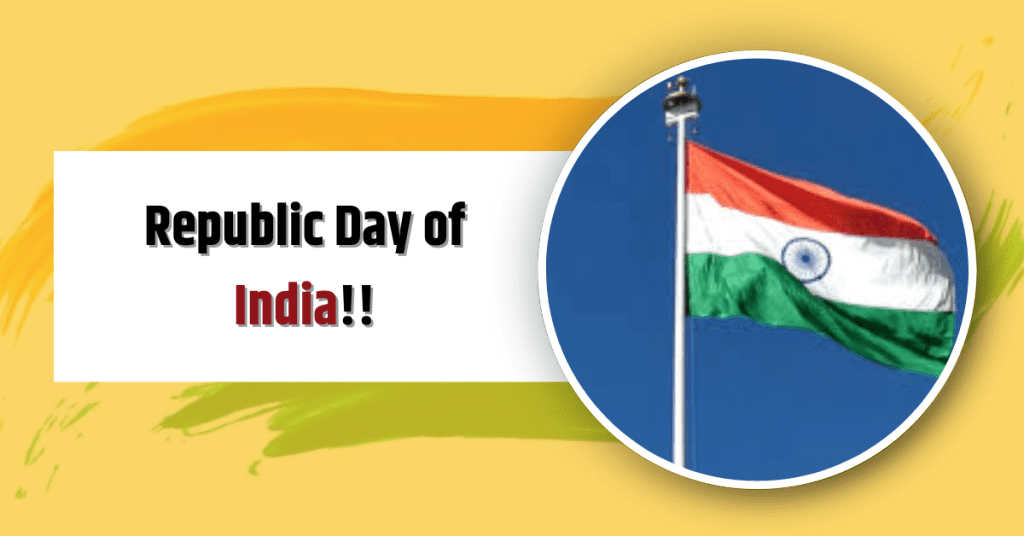Every year on January 26, we celebrate India’s Republic Day. Which is a day commemorating the passing of the Constitution and the country’s conversion to an independent republic. On January 26, 1950, the Indian Constitution went into force, officially transforming the country from a British colony into an independent republic. Under the direction of Dr. B.R. Ambedkar, the Constitution was drafted over the course of nearly three years, and it was ratified on November 26, 1949.
In India’s history and culture, Republic Day of India 2024 and every Republic Day of India hold extremely significance since it celebrates the spirit of freedom and the brave struggle for independence. It stresses the powers of sovereignty and self-governance that the Indian people have been granted by the Constitution.
On this day of patriotism, people from all over the country gather together to celebrate, reflecting both the unity and diversity of India. If you want to know more about Republic Day of India 2024 then make sure you read the following article till the end.
Significance of Republic Day 2024 in India
- Democratic Principles: Republic Day serves as a tribute to the democratic principles and freedom fighters who tirelessly worked towards shaping India’s future.
- Unity and Diversity: The day reaffirms the spirit of freedom and the hard-fought struggle for independence, reflecting the unity and diversity of India.
- Sovereignty and Self-Governance: Republic Day underscores the sovereignty and self-governance bestowed upon the Indian people through the Constitution.
How’s Republic Day of India Celebrated?
The celebrations are a vibrant display of the nation’s rich cultural heritage, military prowess, and the spirit of unity in diversity. Here’s a glimpse of how Republic Day is celebrated in India:
- Flag Hoisting Ceremony: The day begins with the President of India hoisting the national flag at the historic Rajpath in New Delhi. The singing of the national anthem and a 21-gun salute come next. The unfurling of the tricolor symbolizes the essence of the day and the unity of the nation.
- Republic Day Parade: The Republic Day Parade at Rajpath is the centerpiece of the celebrations. It showcases the diversity of India with colorful tableaus representing different states, their culture, art, and traditions. The military, paramilitary forces, and various other contingents participate in a grand march past. The parade also includes displays of military hardware, impressive stunts by armed forces personnel, and the iconic motorcycle daredevils from the Border Security Force.
- Chief Guest and Dignitaries: A chief guest, often a head of state from another nation, is invited to attend the Republic Day celebrations. The presence of a distinguished guest symbolizes India’s diplomatic relations and strengthens international ties. Dignitaries from various fields, including political leaders, foreign ambassadors, and notable personalities, also attend the event.
- Beating Retreat Ceremony: On January 29th, the Beating Retreat Ceremony took place at Vijay Chowk in New Delhi. This musical extravaganza involves performances by the three wings of the military, marking the formal conclusion of Republic Day celebrations. The tunes played during the ceremony evoke a sense of pride and patriotism.
- Cultural Programs: Schools, colleges, and cultural organizations organize various programs to celebrate Republic Day. These events often include patriotic songs, dance performances, and skits that highlight the significance of the day. Educational institutions conduct flag hoisting ceremonies to instill a sense of patriotism among students.
- Decorations and Illuminations: Cities and towns across the country are adorned with the national flag, and government buildings and public spaces are illuminated in the colors of the tricolor. The vibrant displays create a festive atmosphere, fostering a sense of pride and national identity.
- Patriotic Activities: Citizens actively participate in various patriotic activities, including community events, discussions on the Constitution, and awareness campaigns on democratic values. It is a time when people reflect on the importance of being responsible citizens and contributing to the nation’s progress.
History of Republic Day Of India
The seeds of Republic Day were sown decades before its actual birth. The struggle for independence from British rule had been brewing for years, ignited by the fire of nationalistic passion and a yearning for self-governance. This culminated in the historic day of August 15, 1947, when India finally broke free from colonial shackles and stepped into the sunlight of freedom.
But freedom alone wasn’t enough. India needed a guiding light, a framework to navigate its newfound sovereignty. Thus, the drafting of the Constitution, a monumental task, began in 1946. Led by Dr. B.R. Ambedkar, a committee of eminent jurists and leaders poured their hearts and minds into crafting a document that would not only define the structure of the new nation but also enshrine its core values.
Finally, on January 26, 1950, the wait ended. The Indian Constitution, hailed as a masterpiece of jurisprudence and a beacon of hope for a young democracy, came into effect. This marked the birth of the Republic of India, a nation reborn not just free but also democratic, secular, and committed to the ideals of justice, liberty, and equality.
From Ceremony to Commemoration
The date was chosen with deep symbolism. January 26th, 1930, was the day the Indian National Congress declared Purna Swaraj, or complete independence from British rule. Thus, celebrating the birth of the republic on this very day became a powerful act of remembrance, connecting the long struggle for freedom to the dawn of a new era.
Republic Day is not just about looking back; it’s also about looking forward. It’s a day to celebrate the unity in diversity that defines India, where people from all walks of life come together to sing the national anthem and witness the spectacle of the parade. It’s a day to recommit to the ideals of the Constitution and strive for a stronger, more just, and equitable nation.
So, let the spirit of Republic Day not be confined to a single day’s celebrations. Let it be a constant reminder of the sacrifices made, the ideals embodied, and the aspirations to be met. Let it be the bedrock upon which we build a future worthy of the dreams of those who envisioned a democratic, free, and vibrant India.
Republic Day 2024: Chief Guest Of Republic Day of India 2024
India has extended an invitation to President Emmanuel Macron of France to be the chief guest for its 2024 Republic Day celebrations, as confirmed by the Elysee French presidential palace and the Ministry of External Affairs. The statement from the ministry affirmed, “At the invitation of Prime Minister Narendra Modi, H.E. Mr. Emmanuel Macron, President of France, will be visiting India as the Chief Guest for the 75th Republic Day celebrations.”
Let’s delve into the process of selecting India’s Republic Day chief guest, the honor associated with the invitation, and the significance it holds.
Conclusion
The choice of January 26th as Republic Day in India holds deep historical and symbolic significance. This date was not randomly selected but carefully chosen to commemorate the remarkable event in 1930 when the Indian National Congress declared Purna Swaraj, complete independence from British rule. The adoption of the Indian Constitution on January 26, 1950, transformed the nation into a sovereign, democratic republic.
Republic Day of India serves as a powerful reminder of India’s journey from colonial subjugation to self-governance and resonates with the spirit of freedom, unity, and the democratic ideals enshrined in the Constitution. The symbolism embedded in January 26th makes Republic Day a poignant celebration of India’s commitment to its foundational principles and the collective aspirations of its people.
FAQs
Why was 26th January selected to enforce the Constitution?
January 26th was chosen because on this day in 1930, the Indian National Congress declared Purna Swaraj, symbolizing complete independence from British rule.
How did India become a republic on 26 January 1950?
India became a republic on January 26, 1950, with the enforcement of its own Constitution, marking the transition from a dominion under British rule to a sovereign, democratic republic.
Why is Republic Day celebrated more than Independence Day?
Republic Day is celebrated more than Independence Day because it not only commemorates freedom but also the adoption of the Constitution, emphasizing the values and principles that guide the nation’s governance.


I have a great command of sophisticated language and literature because I am an artist at heart as well as a writer by profession. I am able to constantly produce work of a high quality because of my knowledge. I’m well-known for my versatility and am an excellent writer of both creative and technical content. To write content that is both entertaining and customized, I take the approach of getting to know the interests and preferences of my targeted audience.

